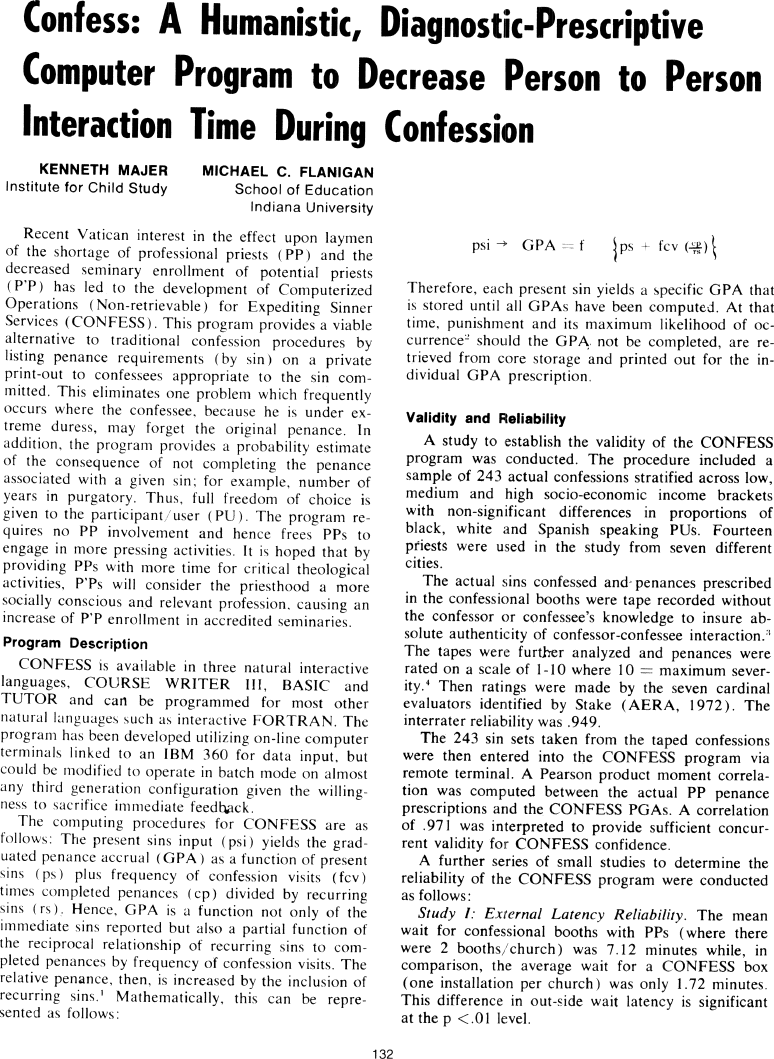The Best of Creative Computing Volume 1 (published 1976)
Confess: A Humanistic Prescriptive Computer Program to Decrease Person to Person Interaction Time During Confession (humor, reprinted from The Journal of Irreproducible Results, 1973)

Confess: A Humanistic, Diagnostic-Prescriptive Computer Program to Decrease
Person to Person Interaction Time During Confession
KENNETH MAJER
Institute for Child Study
MICHAEL C. FLANIGAN
School of Education Indiana University
Recent Vatican interest in the effect upon laymen of the shortage of
professional priests (PP) and the decreased seminary enrollment of potential
priests (P'P) has led to the development of Computerized Operations
(Non-retrievable) for Expediting Sinner Services (CONFESS). This program
provides a viable alternative to traditional confession procedures by listing
penance requirements (by sin) on a private print-out to confessees appropriate
to the sin committed. This eliminates one problem which frequently occurs where
the confessee, because he is under extreme duress, may forget the original
penance. In addition, the program provides a probability estimate of the
consequence of not completing the penance associated with a given sin; for
example, number of years in purgatory. Thus, full freedom of choice is given to
the participant/user (PU). The program requires no PP involvement and hence
frees PPs to engage in more pressing activities. It is hoped that by providing
PPs with more time for critical theological activities, P'Ps will consider the
priesthood a more socially conscious and relevant profession. causing an
increase of P'P enrollment in accredited seminaries.
Program Description
CONFESS is available in three natural interactive languages, COURSE WRITER III,
BASIC and TUTOR and can be programmed for most other natural languages such as
interactive FORTRAN. The program has been developed utilizing on-line computer
terminals linked to an IBM 360 for data input, but could be modified to operate
in batch mode on almost any third generation configuration given the willingness
to sacrifice immediate feedback.
The computing procedures for CONFESS are as follows: The present sins input
(psi) yields the graduated penance accrual (GPA) as a function of present sins
(ps) plus frequency of confession visits (fcv) times completed penances (cp)
divided by recurring sins (rs). Hence, GPA is a function not only of the
immediate sins reported but also a partial function of the reciprocal
relationship of recurring sins to completed penances by frequency of confession
visits. The relative penance, then, is increased by the inclusion of recurring
sins.¹ Mathematically, this can be represented as follows:
psi → GPA = f {ps + fcv (cp÷rs)}
Therefore, each present sin yields a specific GPA that is stored until all GPAs
have been computed. At that time, punishment and its maximum likelihood of
occurrence² should the GPA not be completed, are retrieved from core storage
and printed out for the individual GPA prescription.
Validity and Reliability
A study to establish the validity of the CONFESS program was conducted. The
procedure included a sample of 243 actual confessions stratified across low,
medium and high socio-economic income brackets with non-significant differences
in proportions of black, white and Spanish speaking PUs. Fourteen priests were
used in the study from seven different cities.
The actual sins confessed and penances prescribed in the confessional booths
were tape recorded without the confessor or confessee's knowledge to insure
absolute authenticity of confessor-confessee interaction.³ The tapes were
further analyzed and penances were rated on a scale of 1-10 where 10 = maximum
severity.^4 Then ratings were made by the seven cardinal evaluators identified
by Stake (AERA, 1972). The interrater reliability was .949.
The 243 sin sets taken from the taped confessions were then entered into the
CONFESS program via remote terminal. A Pearson product moment correlation was
computed between the actual PP penance prescriptions and the CONFESS PGAs. A
correlation of .971 was interpreted to provide sufficient concurrent validity
for CONFESS confidence.
A further series of small studies to determine the reliability of the CONFESS
program were conducted as follows:
Study I: External Latency Reliability. The mean wait for confessional booths
with PPs (where there were 2 booths/church) was 7.12 minutes while, in
comparison, the average wait for a CONFESS box (one installation per church) was
only 1.72 minutes. This difference in out-side wait latency is significant at
the p <.01 level.


